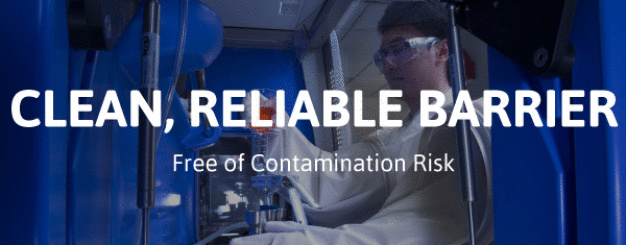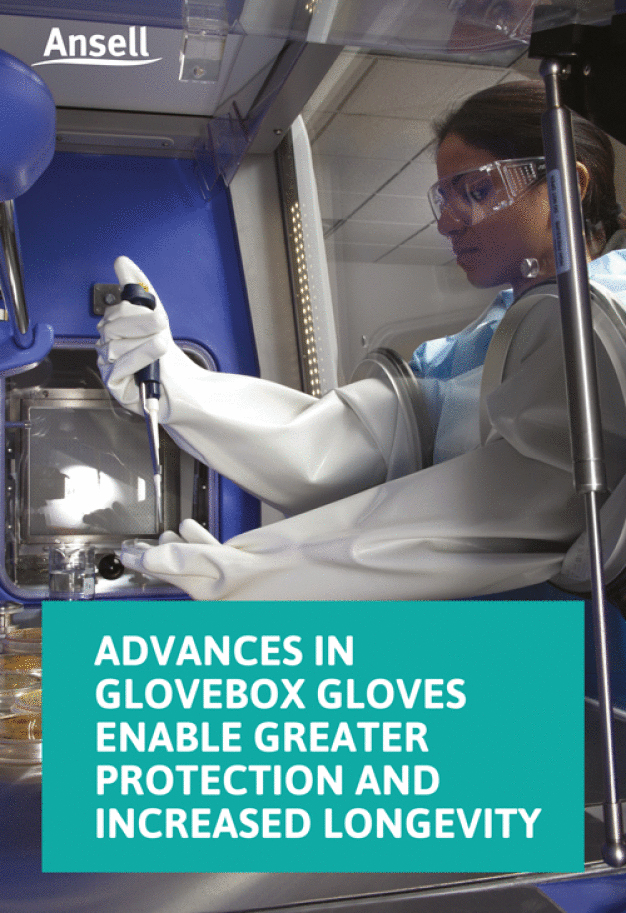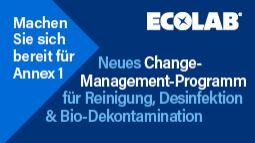Don Cronk, Regulatory Affairs and Technical Services Manager, Ansell
Advances in glovebox gloves enable greater protection and increased longevity
Gloveboxes play a vital role in protecting products from human or environmental contamination as well as protecting individuals and environments from workplace hazards. Designed to provide a controlled, enclosed work environment that is separated from workers by a barrier, they ensure the containment of sensitive and critical materials. The environment inside a glovebox is typically sterile or clean and pressurized, either positively or negatively, to meet the specific requirements of the application.
Gloveboxes are used widely across various industries, from pharmaceutical and electronics manufacturing, to food processing, nuclear applications and more. In pharmaceutical companies alone, it is common to find between 30 and 600 glove ports employed per site. Due to the propensity of sensitive materials utilized in the life sciences, any of three different types of gloveboxes may be used; each is designed for the specific hazards present or level of cleanliness required.
Containment gloveboxes
Containment gloveboxes are specifically designed to protect the operator and ambient environment from the material being processed. Normally operated under negative pressure, containment gloveboxes are commonly found in pharmaceutical applications relating to the development of oral treatments, neurological pain drugs, enhancing drugs, nuclear medicine and other potent drugs. Activities such as weighing and dispensing, filter drying, reactor charging, dryer discharging, centrifuging, blending, fermenting, powder transfer, drum charging, sampling and toxic animal handling are conducted in containment gloveboxes.
Isolation gloveboxes
Isolation gloveboxes protect the material being processed from the operator and/or the environment. Normally operated under positive pressure, isolation gloveboxes are used in applications such as aseptic drug manufacture and filling and the development of parenteral (injectable) drugs. Functions frequently conducted inside isolation gloveboxes include sterile liquid filling, freeze drying, powder filling, tablet pressing, autoclave interfacing, sterility testing and transferring.
Isolators
The third type of glovebox is an isolator, which combines features of containment and isolation gloveboxes, and includes both positive and negative pressure zones. In life sciences applications, these are used in the manufacture of cytotoxic parenteral drugs, some chemotherapy drugs and biopharmaceutical cancer drugs. Capable of ensuring an ultra-clean and ultra-contained space for product protection, isolators are used to contain some of the most dangerous and toxic materials known to man.
GLOVE INTEGRITY IS CRUCIAL
The gloves used inside any type of glovebox provide the vital interface between the worker and the interior glovebox environment, and must maintain a clean, reliable barrier while allowing the worker to effectively conduct manual tasks.1 The gloves’ integrity is crucial, therefore, as a glove breach is a breach in containment that puts workers and/or products at risk of contamination. Because gloves are the weakest protection point of the glovebox, minimizing breaches in the gloves is a significant safety concern in daily operations across life sciences applications.
While glovebox gloves are available in a variety of materials and configurations, the primary factor in selecting a glove is the material from which it is constructed. First and foremost, glove material must be approved for use among the hazards present, such as chemicals or radiation. Glove material is then selected based on other application-specific characteristics including aging and anti-static properties, mechanical performance, FDA compliance and its ability to resist punctures or tears. Ultimately, the glove should ensure the greatest possible protection, comfort, fit and tactility required to conduct manual tasks safely, effectively and efficiently for the duration of its use.
While glovebox gloves have traditionally been manufactured of natural rubber latex and CSM, recent advances in materials such as nitrile offer significantly improved protection, reliability and longevity. With so many critical factors playing into both the safety of ultra-sensitive products and the protection of workers, it is easy to see why selecting the highest-performing glove is crucial in achieving best practices. This article looks at the differences between traditional and innovative glove materials to help safety managers select the safest, most effective and longest lasting glovebox gloves.
PREPARING GLOVES FOR USE
When considering a glove’s overall performance and longevity, one must look not only at the various ways the glove is actively used, but also what the glove is exposed to throughout routine operations. For instance, when gloves reach the end-user, they may undergo sterilization prior to being mounted onto the glovebox. In most cases, gloves are washed in a non-sterile, or dirty, washing room, then wiped down using disinfectants, such as 70 percent IPA (isopropyl alcohol), biocides or a combination of the two. Next, the gloves move into a cleanroom area and sterilization occurs either here or when they are mounted onto the port, a process also referred to as sterilization in place (SIP).
Decontamination and sterilization are achieved through various methods depending on the application, and may include autoclave with high heat or hydrogen peroxide, or other means of environmental and/or chemical exposure. Each time gloves undergo sterilization, they are affected to varying degrees based on the type of glove material and the decontamination methods used. Therefore, the number of sterilization cycles a glove can undergo before replacement should be assessed on an individual basis. Over their service life, glovebox gloves will be exposed to the rigors of decontamination and sterilization processes as frequently as needed.
CHANGING GLOVES
The frequency with which gloves are replaced varies based on the application and depends on a number of factors including degradation of physical properties due to the sterilization process, the presence of pinholes or tears, which represent a breach in the barrier, and overall age of the glove. Over time gloves degrade as a result of exposure to chemicals, ultraviolet light, ozone, ionizing radiation, extreme heat or cold, excess stress and strain, and general wear. Finally, gloves may be replaced due to a product batch change, as a means to avoid cross contamination. By making informed decisions about the type of glove material used, employers can increase the longevity of reliable performance and protection afforded by the gloves – which reduces downtime, improves productivity and promotes cost savings.
KEYS TO PROMOTING GLOVE LONGEVITY
As a general rule, the glovebox glove should be treated as though it is the operator’s skin. While it must be strong and thick enough to provide an impenetrable barrier, it must also ensure the comfort, elasticity and tactility required to ensure manual tasks can be carried out as required. In order to reduce glove replacement, operators should employ general precautions, such as avoiding direct contact with anything that can degrade, puncture or tear the glove, such as sharp or hot objects or corrosive chemicals.
The way in which gloves are stored can also significantly impact their useful lifespan. Because exposure to ultraviolet light and naturally occurring ozone degrades some glove polymers, it is important to avoid storing gloves in the open when they are not yet mounted. For the greatest longevity, store gloves in their original, sealed packaging away from direct light sources until they are to be used.
Beyond these general guidelines, there are many characteristics specific to different materials that directly affect glove performance. Below is a closer look at the attributes of common glove materials as well as brand new offerings and the unique properties they offer.
GLOVE MATERIALS AND THEIR PROPERTIES
Natural Rubber Latex (NRL)
Natural rubber latex is an extremely common and versatile glove material employed across a multitude of industries and applications. An organic compound with highly elastic properties, NRL is prized for its exceptional comfort and fit. Since it meets FDA compliance for food processing, it may safely be used in slicing, packaging, filling and capping applications. NRL is easy to manufacture and is readily available in a range of low-cost price points.
In glovebox applications, however, NRL does not stand up to multiple autoclave cycles and may age more rapidly than other materials. The largest detractor to using NRL gloves in gloveboxes, though, is the health challenge they pose to a large number of workers who experience allergic reactions ranging from skin irritation to anaphylaxis, a potentially life-threatening condition.2 Workers can be affected from direct contact as well as by inhaling airborne latex particles released when someone removes latex gloves.3 While hand dermatitis is the most common condition associated with latex allergy4, reactions can worsen or individuals who were previously not allergic to latex may become sensitized with repeated latex exposure.
Overall, NRL gloves deliver excellent physical performance in most applications, but short glove life, lack of heat and chemical resistance and worker allergies pose sizable hurdles to widespread glovebox application adoption.
Neoprene (polychloroprene)
Neoprene, also known as polychloroprene, is a family of synthetic latex products produced by the polymerization of chloroprene.5 In glovebox applications, neoprene gloves deliver very good elasticity and tactile comfort, though they are not quite as strong as NRL. Neoprene provides slightly increased chemical resistance over NRL, is somewhat flame retardant, and does not pose an allergy risk to workers, making it a popular choice for glovebox applications.
Neoprene ages better than NRL, it withstands a fairly comparable number of decontamination cycles before requiring replacement. While it does not meet FDA compliance for food processing applications, it does offer better chemical resistance against a higher range of chemicals over NRL. Overall, neoprene’s increased chemical resistance without the risk of allergies make it a more suitable choice for a variety of life sciences glovebox applications.
Nitrile
Nitrile is a synthetic, non-solvent based, FDA approved polymer and is an ideal alternative to latex, where the risk of latex allergies is a concern. With excellent anti-static properties preventing the buildup of static electricity Nitrile is ideal for use with flammable liquids and powders. Nitrile can withstand temperatures of up to 121°C and multiple autoclave cycles and does not become sticky like CSM. It can also be sanitized by Gamma Irradiation, Vapourised Hydrogen Peroxide (VHP) and Isopropyl Alcohol (IPA) and non-sterile options can also be washed and processed and packaged within a cleanroom environment, ensuring the gloves are an ultra-low contamination risk before being introduced into the isolator glove box.
Nitrile has major benefits over traditional materials in physical performance with superior puncture resistance, dexterity and user comfort, it also offers excellent chemical resistance providing >8 hours permeation protection against many cytotoxins and the ability to maintain its properties after gamma irradiation. Nitrile
better meets the needs of life sciences applications with significantly improved comfort, protection and performance.
EPDM+ (ethylene-propylene-diene-rubber)
EPDM+ is a premium FDA-approved material (FDA CFR 21 Positive List) designed to withstand repeated autoclave sterilization up to 50 times, significantly reducing the need for glove replacement in comparison to standard latex, neoprene or CSM gloves. EPDM+ is resistant against hydrogen peroxide solutions and common disinfecting chemicals, and withstands temperatures up to 130°C to ensure longevity even after dozens of sterilizations, making it durable and long lasting.
EPDM+ is also unique in its double-layer breach detection system. The glove’s dual-tone coloring — a white outer material covering a black inner layer — allows for easy, instant visual integrity inspection. The glove’s white external layer makes it ideally suited for pharmaceutical applications where visual identification of breaches and contaminants is vital.
EPDM
EPDM features all the same advanced qualities in comfort, protection, durability, heat and chemical resistance, and FDA compliance as EPDM+. The EPDM glove does not feature the white outer layer of an EPDM+ glove.
While gloves with higher protective qualities are traditionally less comfortable to wear, EPDM gloves deliver not only extreme protection and ruggedness, but also a high level of comfort, dexterity and tactile sensitivity to support workers’ muscle activity and enable fine manual tasks. Available in both medium and heavy weights, the increased thickness of heavy-weight EPDM gloves (24mil/0.6mm) adds durability for heavy duty applications.
EPDM resists aging from exposure to oxygen, UV rays and ozone, lending to the material’s longevity, and because it is halogen-free, EPDM is suitable for disposal by incineration. Because the glove material is fully conductive, it is exceptionally suited for semiconductor applications, and its dark coloring makes it an ideal solution in the production of dry powders.
CSM (chlorosulfonated polyethylene)
CSM is a synthetic material, and gloves constructed of it offer a combination of excellent comfort and extreme chemical protection, making them ideally suited for use in critical, heavy duty environments. Available in both medium and heavy weights, the inherent thickness of CSM gloves increases their durability and augments the glovebox’s physical barrier, while their soft, flexible attributes lend to worker comfort and muscle support to improve productivity.
CSM delivers a high level of resistance against concentrated acids and bases such as nitric acid, hydrochloric acid and ammonia, as well as many oxidizing chemicals and alcohols, and can withstand temperatures of up to 120°C, making it an excellent choice among high heat or flammable solvents. Because CSM gloves deliver improved autoclave and gamma performance as well as significantly greater resistance to aging from exposure to UV and ozone compared to neoprene and latex gloves, their use reduces the frequency of glove replacement and downtime. After two to three autoclave cycles, however, the CSM glove’s material will degrade and require replacement.
CSM glove material is white, making contamination easy to detect, but it does not meet FDA standards. Overall, CSM gloves deliver increased worker comfort and product protection which in turn afford greater durability, fewer glove changes and excellent performance in heavy-duty, high-hazard environments.
Nitrile, EPDM+, EPDM and CSM gloves are designed to deliver the highest level of product and worker protection, along with extreme resistance and durability qualities for long-lasting use. Ideally suited for critical applications, these materials offer a diverse range of solutions tailored for the life sciences industry.
Conclusion
While many variations of glovebox glove materials have served life sciences companies for decades, none have come close to delivering the innovative combination of attributes offered by Nitrile, EPDM+, EPDM and CSM. In an industry where a single glove breach can jeopardize overall operations, selecting the appropriate glove for the application is vital. By choosing high-quality glove materials built for optimum comfort, protection and longevity, and manufactured by a trusted, proven leader, employers benefit from decreased risk and increased productivity – a winning combination in any facility.
1. American Glovebox Society AGS-G001-2007, http://www.gloveboxsociety.org/index.asp
2. Mayo Clinic, “Diseases and Conditions: Latex Allergy,” http://www.mayoclinic.org/diseases-conditions/latex-allergy/basics/definition/CON-20024233
3. Mayo Clinic, “Diseases and Conditions: Latex Allergy,” http://www.mayoclinic.org/diseases-conditions/latex-allergy/basics/definition/CON-20024233
4. U.S. National Library of Medicine, National Institutes of Health, “Workers’ compensation claims related to natural rubber latex gloves,” http://www.ncbi.nlm.nih.gov/pmc/articles/PMC128812/
5. Wikipedia, “Neoprene,” https://en.wikipedia.org/wiki/Neoprene
Ansell GmbH
81829 München
Deutschland










